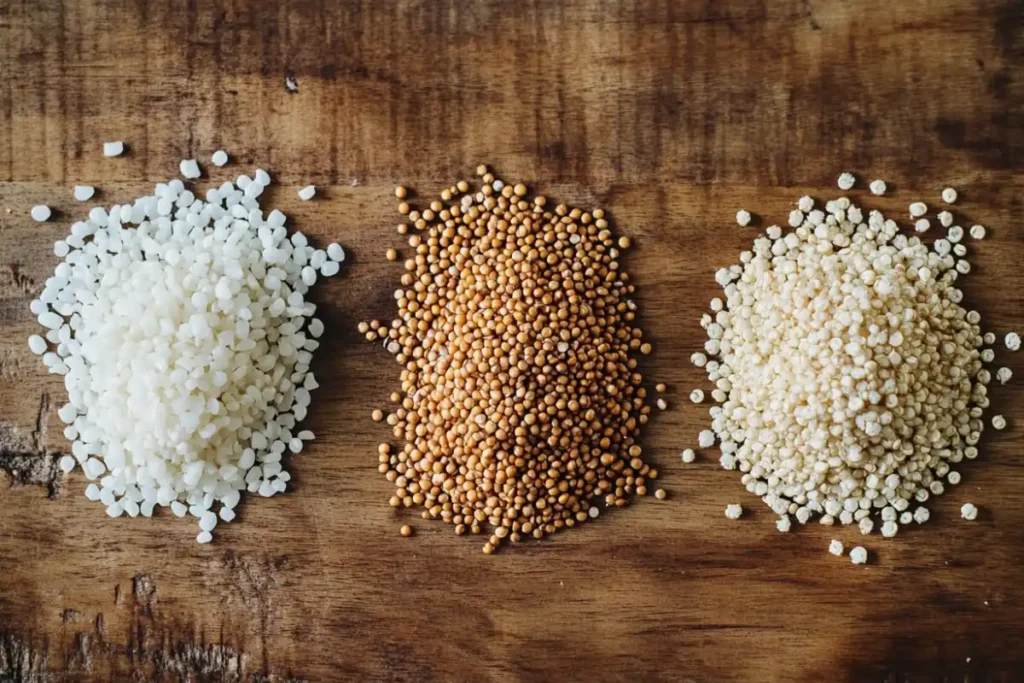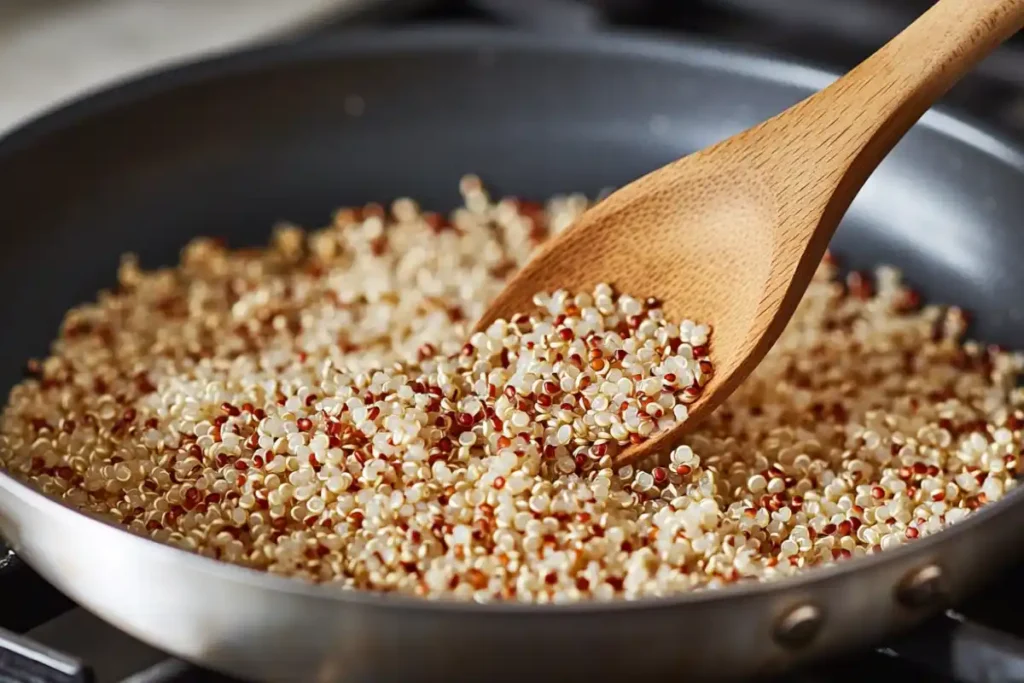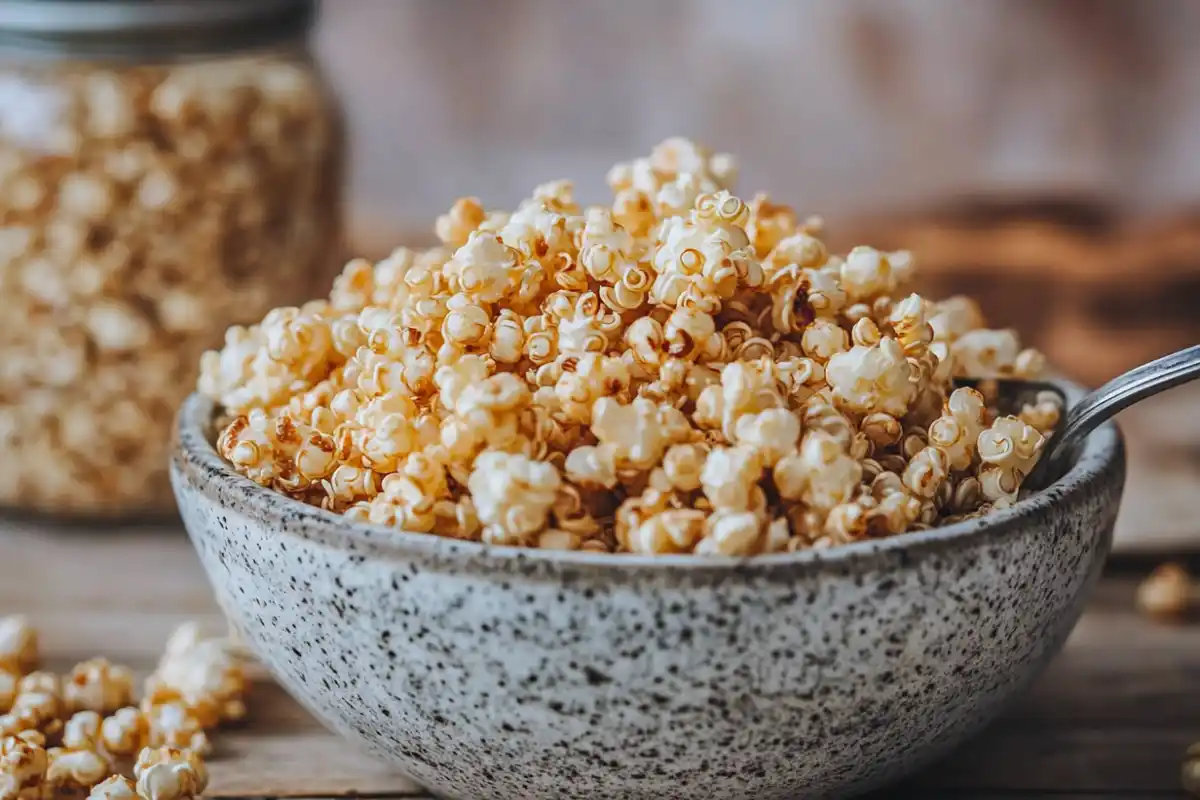Quinoa has become a staple in health-conscious diets, praised for its high protein content and versatility. But when it comes to puffed quinoa, many people wonder: Is puffed quinoa supposed to be crunchy? Some expect it to have a crispy, airy texture similar to puffed rice, while others find it slightly chewy or even soft. The reality is that the texture of puffed quinoa depends on how it’s prepared, stored, and used in recipes.
In this article, we’ll dive deep into what makes puffed quinoa crunchy, why it sometimes isn’t, and how you can make it extra crispy. You’ll also discover creative ways to use it and get answers to the most commonly asked questions. By the end, you’ll know exactly how to achieve the perfect texture for your puffed quinoa.
Understanding Puffed Quinoa and Its Texture
What is Puffed Quinoa?
Puffed quinoa is simply quinoa that has been exposed to heat until it expands, creating a lighter, airier texture. This process is similar to how popcorn pops, but with quinoa, the result is much subtler. Unlike traditional cooked quinoa, which is soft and fluffy, puffed quinoa has a crispier bite—or at least, that’s what most people expect.
Commercially, puffed quinoa is made using high-pressure heat, which rapidly expands the grain. At home, you can achieve similar results by dry-toasting quinoa in a hot pan. The degree of crunchiness, however, depends on several factors, such as heat intensity, cooking time, and whether the quinoa was rinsed beforehand.
How Puffed Quinoa is Made
The process of making puffed quinoa is straightforward, but it requires precision. The two most common methods are:
- Commercial Puffing: Large-scale manufacturers use high-pressure heat to puff quinoa rapidly, making it light and crispy.
- Homemade Puffing: Dry-toasting uncooked quinoa in a pan over medium-high heat until it starts to pop. This method gives you more control over the final texture.
Regardless of the method, the moisture content in quinoa plays a significant role in whether it puffs up properly or turns out chewy instead of crunchy.
Why Some People Expect It to Be Crunchy
If you’ve ever eaten puffed rice or puffed millet, you might assume that puffed quinoa should be just as crunchy. While it does develop some crispiness, it’s typically not as light and airy as other puffed grains. This is because quinoa contains more protein and fiber, which can give it a firmer bite.
That being said, when prepared correctly, puffed quinoa should have a distinct crunch. If yours turns out soft or chewy, don’t worry! In the next section, we’ll explore why this happens and how to make sure your puffed quinoa is perfectly crispy every time.
Is Puffed Quinoa Always Crunchy?
The Role of Cooking Methods in Crunchiness
When people ask, “Is puffed quinoa supposed to be crunchy?” the answer depends largely on how it’s prepared. Puffed quinoa can range from slightly crispy to almost chewy, depending on the method used.
- High-Heat Puffing: When quinoa is quickly heated at a high temperature, it tends to become light and crisp. This is how commercial puffed quinoa is made.
- Dry Toasting: If you toast quinoa in a pan, it can get crunchy, but it may not puff as much as store-bought versions.
- Oven Roasting: Some people prefer to roast quinoa in the oven, which results in a slightly chewier texture.
To get the best results, it’s crucial to use dry, unrinsed quinoa. Excess moisture can prevent the grains from crisping up properly.

Factors That Affect the Crunchiness of Puffed Quinoa
Several key factors influence how crispy puffed quinoa turns out:
- Moisture Content: If the quinoa has been rinsed but not dried properly, it won’t crisp up well.
- Cooking Time: Overcooking can burn the quinoa, while undercooking may leave it chewy.
- Heat Level: Medium-high heat works best for achieving a crisp texture without burning.
- Storage: Even if quinoa is crispy when freshly puffed, storing it in a humid environment can make it lose its crunch.
Comparing Puffed Quinoa to Other Puffed Grains
Puffed quinoa is often compared to puffed rice or puffed millet, but it has a distinct texture:
- Puffed Rice: Very light and airy, almost melts in your mouth.
- Puffed Millet: Slightly denser but still crisp.
- Puffed Quinoa: Tends to be smaller and crunchier, with a nutty flavor.
Understanding these differences helps set realistic expectations for texture. If your puffed quinoa isn’t as crunchy as expected, tweaking the cooking method can make a big difference!
How to Make the Crunchiest Puffed Quinoa
Step-by-Step Guide to Popping Quinoa Perfectly
Want to make sure your puffed quinoa is as crispy as possible? Follow these steps:
- Choose Dry Quinoa: If your quinoa is pre-rinsed, spread it on a towel and let it dry completely before using it.
- Heat a Dry Pan: Use a heavy-bottomed pan and preheat it over medium-high heat.
- Add Quinoa in Small Batches: Too much quinoa at once can lower the pan temperature, making it harder to crisp up.
- Stir Constantly: Keep stirring to ensure even heat distribution and prevent burning.
- Listen for Popping Sounds: Once you hear tiny popping sounds, the quinoa is starting to puff.
- Remove Quickly: Once most of the quinoa has puffed, transfer it to a bowl to prevent overcooking.
This method ensures that your quinoa gets as crispy as possible while keeping its natural nutty flavor.
Common Mistakes That Can Make It Less Crunchy
Even if you follow the steps, a few mistakes can ruin the crunch factor:
❌ Adding oil – Unlike popcorn, quinoa doesn’t need oil to puff up. Oil can make it soggy instead of crunchy.
❌ Using wet quinoa – Moisture prevents quinoa from crisping up, leaving it chewy.
❌ Cooking at too low a temperature – If the heat is too low, quinoa will toast instead of puffing, giving it a dense texture.
Best Oils and Temperatures for Extra Crispiness
Although you don’t need oil for puffing quinoa, you can enhance its crunch by tossing it with a bit of coconut oil or avocado oil after puffing. This helps it stay crisp longer, especially if you plan to store it.
For the best results:
- Dry puffing temperature: ~375°F (190°C) in a hot pan
- Oven roasting for extra crunch: 300°F (150°C) for 10 minutes after puffing
By following these tips, you can make sure your puffed quinoa stays light, crispy, and delicious!

Alternative Uses for Puffed Quinoa
Using Puffed Quinoa in Sweet and Savory Dishes
Once you’ve mastered making crispy, crunchy puffed quinoa, the next step is using it in creative ways. This versatile ingredient can be added to both sweet and savory recipes for an extra layer of texture and flavor.
Sweet Dishes
- Granola and Cereal: Mix puffed quinoa into homemade granola or breakfast bowls for a light, crunchy bite.
- Energy Bars: Combine it with nut butter, honey, and chocolate for a healthy, no-bake energy bar.
- Smoothie Toppings: Sprinkle over smoothie bowls for added crunch.
Savory Dishes
- Salads: Use puffed quinoa as a topping for salads to add a nutty, crispy texture.
- Soup Garnish: Just like croutons, puffed quinoa can be sprinkled over soups for an extra bite.
- Coating for Meat or Tofu: Mix it with spices to create a crunchy crust for baked chicken or tofu.
Enhancing Crunchiness in Granola, Salads, and More
If you want to keep puffed quinoa crunchy in recipes, here are some tips:
– Store it in an airtight container to prevent it from getting soft.
– Add it to granola after baking to retain its crispiness.
– Use it as a last-minute topping instead of mixing it into moist foods.
Pairing Puffed Quinoa with Other Textures
To create balanced dishes, pair puffed quinoa with ingredients that contrast its texture:
- Creamy: Yogurt, nut butter, or avocado.
- Chewy: Dried fruit or caramel.
- Crunchy: Nuts, seeds, or toasted coconut.
By experimenting with different combinations, you can elevate your dishes and make puffed quinoa the star ingredient.
FAQs – Common Questions About Puffed Quinoa
1. Why is my puffed quinoa not crunchy?
If your puffed quinoa turns out soft or chewy instead of crunchy, a few factors might be the culprit:
- Too much moisture: Make sure your quinoa is completely dry before puffing.
- Low heat: Cooking at a lower temperature can prevent proper puffing.
- Overcrowding the pan: Puffing too much quinoa at once lowers the heat and causes uneven results.
2. Is puffed quinoa supposed to be crunchy or soft?
Many people ask, Is puffed quinoa supposed to be crunchy? The answer is that it should have a light, crispy texture, but it won’t be as airy as puffed rice. If it’s too soft, try adjusting your cooking method to ensure maximum crunch.
3. How do you store puffed quinoa to keep it crunchy?
To maintain its crunchiness, store puffed quinoa in an airtight container at room temperature. Avoid moisture exposure, as humidity can make it soft. If it starts losing its crispness, lightly toast it in a dry pan for a few minutes to refresh its crunch.
4. Can you toast puffed quinoa to make it crunchier?
Yes! If your puffed quinoa isn’t as crunchy as you’d like, you can spread it on a baking sheet and bake it at 300°F (150°C) for 5-10 minutes. This will remove excess moisture and give it a more pronounced crispness.
Conclusion
So, is puffed quinoa supposed to be crunchy? The answer is yes, but with some variation. While puffed quinoa naturally has a light, crisp texture, it won’t be as airy as puffed rice. The key to getting it perfectly crunchy lies in using the right heat, keeping it dry, and storing it properly.
Now that you know how to make and use puffed quinoa, why not experiment with it in your kitchen? Whether you’re adding it to granola, using it as a crispy salad topper, or making homemade energy bars, this nutritious ingredient brings both texture and flavor to a variety of dishes.
If your puffed quinoa isn’t as crunchy as you’d like, don’t worry! A quick toasting session in the oven or a slight tweak in your cooking method can easily fix it. Keep experimenting, and soon, you’ll master the art of making crispy, crunchy, and delicious puffed quinoa!
